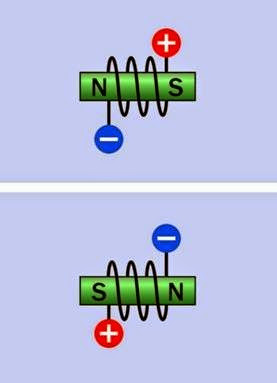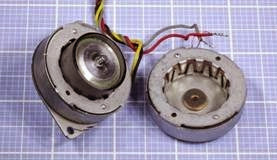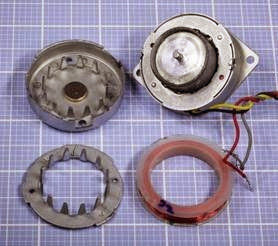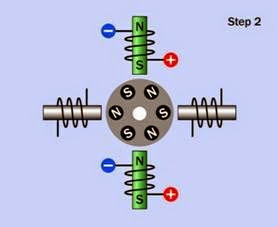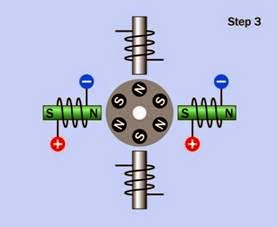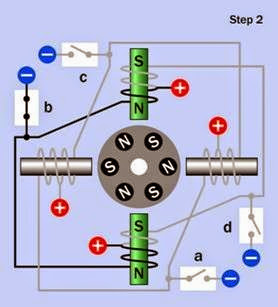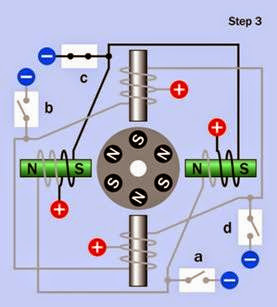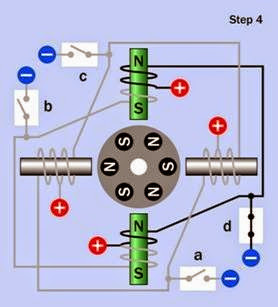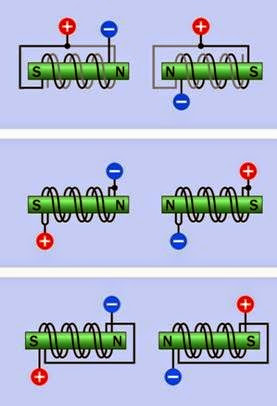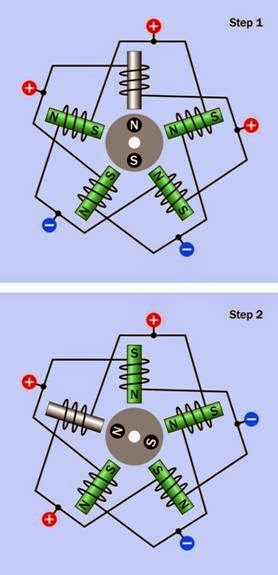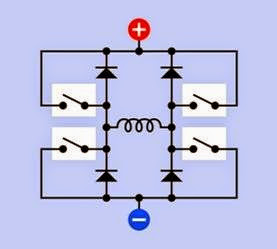Also often referred to as a stepping motor, and sometimes known as a step motor. It is a type of induction motor but merits its own entry in this encyclopedia as it has acquired significant and unique importance in electronics equipment where precise positioning of a moving part is needed and digital control is available.
What It Does
A stepper motor rotates its drive shaft in precise steps in response to a timed sequence of pulses (usually one step per pulse). The pulses are de livered to a series of coils or windings in the sta tor, which is the stationary section of the motor, usually forming a ring around the rotor, which is the part of the motor that rotates. Steps may also be referred to as phases, and a motor that rotates in small steps may be referred to as having a high phase count.
A stepper motor theoretically draws power for its stator coils at a constant level that does not vary with speed. Consequently the torque tends to decrease as the speed increases, and conversely, it is greatest when the motor is stationary or locked.
The motor requires a suitable control system to provide the sequence of pulses. The control sys tem may consist of a small dedicated circuit, or a microcontroller or computer with the addition of suitable driver transistors capable of handling
the necessary current. The torque curve of a mo tor can be extended by using a controller that increases the voltage as the speed of the control pulses increases.
Because the behavior of the motor is controlled by external electronics, and its interior is usually symmetrical, a stepper motor can be driven back ward and forward with equal torque, and can also be held in a stationary position, although the stator coils will continue to consume power in this mode.
How It Works
The stator has multiple poles made from soft iron or other magnetic material. Each pole is either energized by its own coil, or more commonly, several poles share a single, large coil. In all types of stepper motor, sets of stator poles are mag netized sequentially to turn the rotor and can re main energized in one configuration to hold the rotor stationary.
The rotor may contain one or more permanent magnets, which interact with the magnetic fields
generated in the stator. Note that this is different from a squirrel-cage AC motor in which a “cage” is embedded in the rotor and interacts with a ro tating magnetic field, but does not consist of permanent magnets.
Three small stepper motors are shown in Figure 25-1. Clockwise from the top-left, they are four-wire, five-wire, and six-wire types (this dis tinction is explained in the following section). The motor at top-left has a threaded shaft that can engage with a collar, so that as the motor shaft rotates counter-clockwise and clockwise, the collar will be moved down and up.
Figure 25-1. Three small stepper motors.
Reluctance Stepper Motors
The simplest form of stepper motor uses a rotor that does not contain permanent magnets. It re lies on the principle of variable reluctance, reluc tance being the magnetic equivalent of electrical resistance. The rotor will tend to align its protrud ing parts with the exterior source(s) of the mag netic field, as this will reduce the reluctance in the system. Additional information about vari able reluctance is included in “Reluctance Mo tor” (page 197) in the section of this encyclope dia dealing with the AC motor.
A variable reluctance motor requires an external controller that simply energizes the stator coils sequentially. This is shown in Figure 25-2, where six poles (energized in pairs) are arrayed sym metrically around a rotor with four protrusions, usually referred to as teeth. Six stator poles and four teeth are the minimum numbers for reliable performance of a reluctance stepper motor.
In the diagram, the core of each pole is tinted green when it is magnetized, and is gray when it is not magnetized. In each section of this dia gram, the stator coils are shown when they have just been energized, and the rotor has not yet had time to respond. External switching to ener gize the coils has been omitted for simplicity. In a real motor, the rotor would have numerous ridges, and the clearance between them and the stator would be extremely narrow to maximize the magnetic effect.
In a 6-pole reluctance motor where the rotor has four teeth, each time the controller energizes a new pair of poles, the rotor turns by 30 degrees counter-clockwise. This is known as the step an gle, and means that the motor makes 12 steps in each full 360-degree rotation of its shaft. This configuration is very similar to that of a 3-phase AC induction motor, as shown in Figure 23-11 in the AC motor section of this encyclopedia. How ever, the AC motor is designed to be plugged into a power source with a constant frequency, and is intended to run smoothly and continuously, not in discrete steps.
Generally, reluctance motors tend to be larger than those with magnetized rotors, and often re quire feedback from a sensor that monitors shaft angle and provides this information to control electronics. This is known as a closed loop system. Most smaller stepper motors operate in an open loop system, where positional feedback is con sidered unnecessary if the number of pulses to the motor is counted as a means of tracking its position.
Figure 25-2. In a variable reluctance stepper motor, the rotor moves to minimize magnetic reluctance each time the next pair of coils is energized. At each step, the coils have been energized a moment before the rotor has had time to respond.
Permanent Magnet Stepper Motors
More commonly, the rotor of a stepper motor contains permanent magnets, which require the controller to be capable of reversing the mag netic field created by each of the stator coils, so that they alternately attract and repel the rotor magnets.
In a bipolar motor, the magnetic field generated by a coil is reversed simply by reversing the cur rent through it. This is shown diagrammatically in Figure 25-3. In a unipolar motor, the magnetic field is reversed by applying positive voltage to the center tap of a coil, and grounding one end or the other. This is shown diagrammatically in Figure 25-4.
Figure 25-3. In a bipolar motor, the magnetic field gener- ated by each stator coil is reversed simply by reversing the current through the coil.
Either type of motor is often designed with an upper and lower deck surrounding a single rotor,
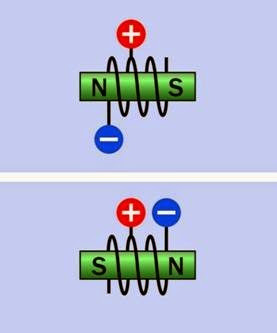 Figure 25-4. The magnetic field of this coil is reversed by applying positive voltage constantly to a center tap and grounding one end of the coil or the other.
Figure 25-4. The magnetic field of this coil is reversed by applying positive voltage constantly to a center tap and grounding one end of the coil or the other.
as suggested in Figure 25-5. A large single coil, or center-tapped coil, induces a magnetic field in multiple poles in the top deck, out of phase by one step with a second set of poles, energized by their own coil, in the bottom deck. (All three mo tors shown in Figure 25-1 are of this type.) The rotor of the motor is tall enough to span both decks, and is rotated by each of them in turn.
In Figure 25-6, the decks of a two-deck four-wire motor have been split apart. The rotor remains in the left-hand section. It is enclosed within a black cylinder that is a permanent magnet divi ded into multiple poles. In the right-hand sec tion, a coil is visible surrounding metal “teeth” that function as stator poles when the coil is energized.
In Figure 25-7, the same motor has been further disassembled. The coil was secured with a length of tape around its periphery, which has been re moved to make the coil visible. The remaining
Figure 25-5. A simplified rendering of the common “two deck” type of motor. See text for details.
Figure 25-6. A two-deck stepper motor split open to re- veal its rotor (left) and one of the stators (right) encircled by a coil.
half of the motor, at top-right, contains a second, concealed but identical coil with its own set of poles, one step out of phase with those in the first deck.
Because the field effects in a two-deck stepper motor are difficult to visualize, the remaining di agrams show simplified configurations with a minimum number of stator poles, each with its own coil.
Figure 25-7. The stepper motor from the previous figure, further disassembled.
Bipolar Stepper Motors
The most basic way to reverse the current in a coil is by using an H-bridge configuration of switches, as shown in Figure 25-8, where the green arrow indicates the direction of the magnetic field. In actual applications, the switches are solid-state. Integrated circuits are available containing all the necessary components to control a bipolar stepper motor.
Four sequential steps of a bipolar motor are shown in Figure 25-9, Figure 25-10, Figure 25-11, and Figure 25-12. The H-bridge control electronics for each coil are omitted for clarity. As before, energized coils are shown with the pole inside the coil tinted green, while non- energized coils are gray, and the rotor is shown before it has had time to respond to the magnetic field in each step.
Unipolar Motors
The control electronics for a unipolar motor can be simpler than those for a bipolar motor, as off- the-shelf switching transistors can ground one end of the coil or the other. The classic five-wire unipolar stepper motor, often sold to hobbyists and used in robotics projects and similar appli cations, can be driven by nothing more elaborate
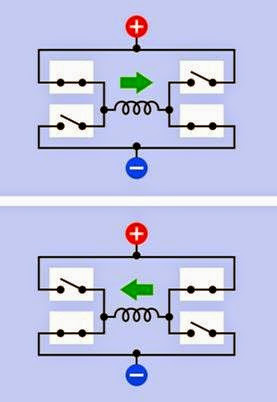 Figure 25-8. The simplest and most basic way to reverse the current through a coil is via an H-bridge circuit. In practice, the switches are replaced by solid-state compo- nents.
Figure 25-8. The simplest and most basic way to reverse the current through a coil is via an H-bridge circuit. In practice, the switches are replaced by solid-state compo- nents.
Figure 25-9. A bipolar stepper motor depicted a moment before the rotor has had time to make its first step in re- sponse to magnetic fields created by the stator coils.
Figure 25-10. The bipolar stepper motor from the previ- ous figure is shown with its rotor having advanced by one step, and coil polarity changed to induce it to make a sec- ond step.
Figure 25-11. The bipolar stepper motor after taking its second step, immediately before making its third step.
than a set of 555 timer chips. However, this type of motor is less powerful for its size and weight because only half of each coil is energized at a time.
In Figure 25-13, Figure 25-14, Figure 25-15, and Figure 25-16, the simplest configuration of a uni polar system is shown in diagrammatic form us ing four stator coils and a rotor containing six magnetic poles. Each figure shows the stator coils when they have just been energized, a mo
Figure 25-12. The bipolar stepper motor after taking its third step. When the rotor responds to the new pattern of magnetic fields, its orientation will be functionally identi- cal with that shown in the first step.
ment before the rotor has had time to move in response to them. Coils that are energized are shown with the metal cores tinted green. Wires that are not conducting current are shown in gray. The open and closed positions of switches a, b, c, and d suggest the path that current is tak ing along the wires that are colored black.
Note that coils on opposite sides of the motor are energized simultaneously, while the other pair of coils is de-energized. Adjusting the controller so that it overlaps the “on” cycles of the coils can generate more torque, while consuming more power.
A motor containing more stator poles can ad vance in smaller steps, if the poles are separately energized. However, if the coils have individual windings, this will increase the cost of the motor.
Variants
In addition to bipolar and unipolar variants, pre viously described, three others are available.
High Phase Count
This term describes any type of stepper motor in which additional poles reduce the step size. The advantages of a high phase count include
Figure 25-13. The coils of this unipolar stepper motor are shown an instant after they have been energized, before the rotor has had time to respond by making its first step.
Figure 25-14. The same motor from the previous figure is shown with coils energized to induce the rotor to make its second step.
Figure 25-15. The same motor from the previous figure is shown with coils energized to induce the rotor to make its third step.
Figure 25-16. When the rotor makes its fourth step, it will be back in an orientation that is functionally identical with the first figure in this series.
smoother running at high speed and greater precision when selecting a desired motor posi tion. The additional coils also enable higher pow er density, but naturally tend to add to the cost of the motor.
Hybrid
This type of motor uses a toothed rotor that pro vides variable reluctance while also containing permanent magnets. It has become relatively common, as the addition of teeth to the rotor enables greater precision and efficiency. From a control point of view, the motor behaves like a regular permanent-magnet stepper motor.
Bifilar
In this type of motor, also sometimes known as a universal stepper motor, two coils are wound in parallel for each stator pole. If there are two poles or sets of poles, and both ends of each winding are accessible via wires that are run out of the motor, there will be eight wires in total. Conse quently this type is often referred to as an 8-wire motor.
The advantage of this scheme is that it allows three possible configurations for the internal coils. By shorting together the wires selectively, the motor can be made to function either in uni polar or bipolar mode.
In Figure 25-17, the upper pair of simplified dia grams depicts one end of one coil connected to the beginning of the other, while positive voltage is applied at the midpoint, as in a unipolar motor. The magnetic polarity of the coil is determined by grounding either end of the coil. The section of each coil that is not conducting current is shown in gray.
The center pair of diagrams shows the adjacent ends of the coils tied together, so that they are now energized in parallel, with the magnetic po larity being determined by the polarity of the voltage, as in a bipolar motor.
The coils may also be connected in series, as shown in the lower pair of diagrams. This will provide greater torque at low speed and lower torque at high speed, while enabling higher- voltage, lower-current operation.
Figure 25-17. In a bifilar motor, two coils are wound in par- allel around each stator pole and can be connected with a center tap to emulate a unipolar motor (upper diagrams), or can be energized in parallel (middle diagrams) or series (lower diagrams) to emulate a bipolar motor.
Multiphase
In a multiphase motor, multiple stator coils are usually connected in series, with a center tap ap plied between each pair. A possible configura tion is shown in Figure 25-18, where the two di agrams show two consecutive steps in rotation, although the step angle could be halved by changing the voltage polarity in only one loca tion at a time. The way in which the motor is wired
enables only one stator coil to be unpowered during any step, because its two ends are at equal potential. Therefore this type of motor is capable of high torque in a relatively small format.
In some multiphase motors, additional wires al low access to both ends of each coil, and the coils are not connected internally. This allows control of the motor to be customized.
Microstepping
An appropriately designed stepper motor can be induced to make very small, intermediate steps if the control voltage is modulated to intermedi ate levels. Step angles as low as 0.007 degrees are claimed by some manufacturers. However, a mo tor running in this mode is less able to generate torque.
The simplest form of microstepping is half- stepping. To achieve this in a unipolar motor, each coil passes through an “off” state before its magnetic polarity is reversed.
Sensing and Feedback
So long as the series of pulses to the motor allows the rotor ample time to respond, no feedback mechanism from the rotor is necessary to con firm its position, and an open-loop system is suf ficient. If sudden acceleration, deceleration, load fluctuations, and/or rotation reversal will occur, or if high speeds are involved, a closed loop sys tem, in which a sensor provides positional feed back, may be necessary.
Voltage Control
Rapid stepping of a motor requires rapid creation and collapse of magnetic fields in the stator windings. Therefore, self-inductance of the windings can limit the motor speed. One way to overcome this is to use a higher voltage. A more sophisticated solution is to use a controller that provides a high initial voltage, which is reduced or briefly interrupted when a sensor indicates that coil current has increased sufficiently to overcome the self-inductance of the windings
Figure 25-18. A multiphase stepper motor. By applying voltage in the pattern shown, only one coil is not ener- gized during each step. This enables high torque com- pared with the size of the motor.
and has reached its imposed limit. This type of controller may be referred to as a chopper drive as the voltage is “chopped,” usually by power transistors. It is a form of pulse width modulation.
The step angle of a stepper motor is the angular rotation of its shaft, in degrees, for each full step. This will be determined by the physical construc tion of the motor. The coarsest step angle is 90 degrees, while sophisticated motors may be ca pable of 1.8 degrees (without microstepping).
The maximum torque that a motor can deliver is discussed in “Values” (page 184) in the DC mo tor entry of this encyclopedia.
Motor weight and size, shaft length, and shaft diameter are the principal passive values of a stepper motor, which should be checked before it is selected for use.
How to Use it
• Cheap controller hardware where open- loop applications are acceptable
• High reliability, since no brushes or commu tator are involved
Disadvantages include:
• Noise and vibration
• Resonance at low speeds
• Progressive loss of torque at high speeds
Protection Diodes
While a small stepper motor may be driven di rectly from power transistors, darlington pairs, or even 555 timers, larger motors will create back- EMF when the magnetic field of each stator coil
is induced or forward EMF when the field is al
Stepper motors are used to control the seek ac tion in disk drives, the print-head movement and paper advance in computer printers, and the scanning motion in document scanners and cop iers.
Industrial and laboratory applications include the adjustment of optical devices (modern tele scopes are often oriented with stepper motors), and valve control in fluid systems.
A stepper motor may be used to power a linear actuator, usually via a screw thread (properly known as a lead screw) or worm gear. For more on linear actuators, see “Linear Actuator” (page 184). While the stepper motor will enable greater accuracy than a traditional DC motor, the gearing inevitably will introduce some imprecision.
Advantages of stepper motors include:
• Precise positioning, typically within 3 per cent to 5 percent per step. The percentage step error does not accumulate as the motor rotates
• Able to run at a wide range of speeds, in cluding very slow speeds without reduction gearing
• Trouble-free start, stop, and reverse action
lowed to collapse, and bipolar motors will also induce voltage spikes when the current reverses. In a unipolar motor, while only one-half of the coil is actually energized via its center tap, the other half will have an induced voltage, as the coil acts like a linear transformer.
A simplified schematic illustrating diode place ment for a bipolar motor is shown in Figure 25-19.
Figure 25-19. The H-bridge circuit must be augmented with protection diodes to guard against back-EMF created by fluctuating current in the stator coil.
Integrated circuit chips are available taht incor porate protection diodes, in addition to the nec essary power transistors. Stepper motors may al so have protection diodes built in. Consult the manufacturer’s datasheet for details before at taching a motor to a power source.
Positional Control
The built-in control electronics of a servo mo tor typically turn the shaft to a precisely known position in response to pulse-width modulation from an exterior source such as a microcontrol ler, whereas the angle of rotation of a stepper motor in an open-loop system must be calcula ted by counting the number of steps from an in itial, home position. This limitation of a stepper motor can be overcome by using a closed-loop system, but that will require monitoring the mo tor, adding complexity to the external controller. The choice between stepper and servo motors should be evaluated on a case-by-case basis.
What Can Go Wrong
General problems affecting all types of motors are listed in “Heat effects” (page 188). Issues re lating more specifically to stepper motors are lis ted in the following sections.
Incorrect Wiring
Because a stepper motor is driven via multiple conductors, there is a significant risk of wiring errors, especially since many motors are not iden tified with part numbers. The first challenge, then, may be to determine what type of motor it is. When the motor is disconnected from any power, and the shaft is rotated with finger and thumb, a magnetized-rotor motor will not spin as freely as a reluctance motor, because the mag nets in the rotor will provide intermittent turning resistance.
If a unipolar motor is relatively small and is fitted with five wires, almost certainly the motor con tains two coils, each with a center tap, and their function can be determined by applying positive
voltage to the red wire and grounding each of the other wires in turn. Attaching a small piece of tape to the motor shaft will assist in viewing its orientation.
A multimeter set to measure ohms can also be useful in deducing the internal coil connections of the motor, since the end-to-end resistance of a coil should be approximately twice the resist ance between the center tap and either end of the coil.
A multiphase motor may have five wires, but in this case, the resistance between any two non- adjacent wires will be 1.5 times the resistance between any two adjacent wires.
Step Loss
In an open-loop system, if the motor skips or misses pulses from the controller, the controller no longer has an accurate assessment of the shaft angle. This is known as step loss. Since this can be caused by sudden changes in control fre quency, the frequency should be increased (or decreased) gradually. This is known as ramping the motor speed. Stepper motors cannot re spond instantly to changes in speed, because of inertia in the rotor or in the device that the motor is driving.
Where the motor turns one or more steps beyond its commanded stopping point, this is known as overshoot.
Step loss may also occur if the motor continues turning after power has been interrupted (either intentionally or because of an external fault). In an open-loop system, the controller should be designed to reset the motor position when pow er is initiated.
Excessive Torque
When the motor is stationary and not powered, detent torque is the maximum turning force that can be applied without causing the shaft to turn. When the motor is stationary and the controller does deliver power to it, holding torque is the maximum turning force that can be applied
without causing the shaft to turn, and pull-in tor que is the maximum torque which the motor can apply to overcome resistance and reach full speed. When the motor is running, pull-out tor que is the maximum torque the motor can deliver without suffering step loss (pulling it out of sync with its controller). Some or all of these values should be specified on the motor’s datasheet. Exceeding any of them will result in step loss.
Hysteresis
When a controller directs a stepper motor to seek a specified position, the term hysteresis is often used to mean the total error between the actual position it reaches when turning clockwise, and the actual position it reaches when turning counter-clockwise. This difference may occur be cause a stepper motor tends to stop a fraction short of its intended position, especially under significant load. Any design that requires preci sion should be tested under real-world condi tions to assess the hysteresis of the motor.
Resonance
A motor has a natural resonant frequency. If it is stepped near that frequency, vibration will tend to be amplified, which can cause positional er rors, gear wear (if gears are attached), bearing wear, noise, and other issues. A good datasheet should specify the resonant frequency of the motor, and the motor should run above that fre quency if possible. The problem can be ad dressed by rubber motor mounts or by using a resilient component, such as a drive belt, in con junction with the drive shaft. Damping the vibra tion may be attempted by adding weight to the motor mount.
Note that if the motor has any significant weight attached directly to its shaft, this will lower its resonant frequency, and should be taken into account.
Resonance may also cause step loss (see preced ing sections).
Hunting
In a closed-loop system, a sensor on the motor reports its rotational position to the controller, and if necessary, the controller responds by ad justing the position of the motor. Like any feed back system, this entails some lag time, and at certain speeds the motor may start hunting or oscillating as the controller over-corrects and must then correct its correction. Some closed- loop controllers avoid this issue by running most ly in open-loop mode, using correction only when the motor experiences conditions (such as sudden speed changes), which are likely to cause step loss.
Saturation
While it may be tempting to increase the torque from a stepper motor by upping the voltage (which will increase the current through the sta tor coils), in practice motors are usually designed so that the cores of the coils will be close to sat uration at the rated voltage. Therefore, increas ing the voltage may achieve very little increase in power, while causing a significant increase in heat.
Rotor Demagnetization
The permanent magnets in a rotor can be parti ally demagnetized by excessive heat. Demag netization can also occur if the magnets are ex posed to high-frequency alternating current when the rotor is stationary. Therefore, attempt ing to run a stepper motor at high speed when the rotor is stalled can cause irrevocable loss of performance.



